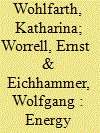|
|
|
Sort Order |
|
|
|
Items / Page
|
|
|
|
|
|
|
| Srl | Item |
| 1 |
ID:
097442


|
|
|
|
|
| Publication |
2010.
|
| Summary/Abstract |
Bangladesh has good potential for harnessing renewable energy sources such as solar, biomass, wind, and mini-hydropower. The country has been experiencing a gradual shift towards exploring renewable energy resources as a driving force for rural development. A few public sector and non-government organizations have started to develop renewable energy technology (RET) projects in rural areas. The lessons learnt from different demonstrations of RET projects reveal that with careful forward planning renewable energy can provide far-reaching economic, environmental, and social benefits to people living in remote rural areas in Bangladesh. This paper identifies some of the barriers that need to be overcome for the successful development of renewable energy technology sector and betterment of rural livelihoods. It does so through a critical review of policy and institutional settings, as well as present status and lessons learnt from pilot demonstration of a number of RET projects undertaken by different organizations. The study highlights policy implications of the review with the aim of supporting decision makers in formulating renewable energy policies and future plans for Bangladesh.
|
|
|
|
|
|
|
|
|
|
|
|
|
|
|
|
| 2 |
ID:
097486


|
|
|
|
|
| Publication |
2010.
|
| Summary/Abstract |
Bangladesh has good potential for harnessing renewable energy sources such as solar, biomass, wind, and mini-hydropower. The country has been experiencing a gradual shift towards exploring renewable energy resources as a driving force for rural development. A few public sector and non-government organizations have started to develop renewable energy technology (RET) projects in rural areas. The lessons learnt from different demonstrations of RET projects reveal that with careful forward planning renewable energy can provide far-reaching economic, environmental, and social benefits to people living in remote rural areas in Bangladesh. This paper identifies some of the barriers that need to be overcome for the successful development of renewable energy technology sector and betterment of rural livelihoods. It does so through a critical review of policy and institutional settings, as well as present status and lessons learnt from pilot demonstration of a number of RET projects undertaken by different organizations. The study highlights policy implications of the review with the aim of supporting decision makers in formulating renewable energy policies and future plans for Bangladesh.
|
|
|
|
|
|
|
|
|
|
|
|
|
|
|
|
| 3 |
ID:
171367


|
|
|
|
|
| Summary/Abstract |
To accommodate the increasing share of intermittent renewable energy, options need to be evaluated to maintain a profitable, secure and sustainable energy supply. Besides energy efficiency (EE) as “first fuel”, adapting demand to meet the variable supply needs to be evaluated. We focus on concepts of energy efficiency and load flexibility (further: demand response; DR) and compare the two types of measures with respect to the diffusion of actions taken and possible drivers and barriers affecting uptake, we derive recommendations to promote the measures more effectively and synergistically. We analyse the results of a survey of more than 1500 service sector companies in Germany and supplement the results with research on German policies promoting energy efficiency and how these could also promote DR. We use logistic regression models to assess and compare influencing factors. Energy efficiency measures are much more prevalent than demand response measures, while most of the influencing factors for both are comparable. More information and standardisation will be needed to tap the demand response potential. We assume that the successful instruments and policies for energy efficiency could also be applied to foster demand response. Especially, instruments such as Energy Efficiency Networks could be redesigned to include demand response. The same holds for other established, effective regulatory instruments like energy audits, which could be enhanced by adding demand response. Although energy efficiency and demand response measures might counteract in specific cases, promoting DR measures can to a large extent built synergistically on existing energy efficiency policy.
|
|
|
|
|
|
|
|
|
|
|
|
|
|
|
|
| 4 |
ID:
183083


|
|
|
|
|
| Summary/Abstract |
Since the Paris Agreement of 2015, 195 countries, including Belgium, have committed themselves to keep the earth from becoming warmer than 1,5 °C since pre-industrial levels. By building and renovating in a more sustainable way, greenhouse gasses can be contained. Previous studies already demonstrated the influence and decisive role of the individual homeowner in energy retrofitting. Recent research highlights that energy efficient renovations are not a solo slim game by the homeowner itself, but a collaboration between various intermediaries and the homeowner. By conducting in-depth interviews, with a focus on the installation of heat pump technology, we identified a series of drivers and barriers that intermediaries experience when installing heat pumps. These drivers and barriers where structured and analyzed according to the “Alphabet theory-framework”. As a result, this paper provides four concrete propositions that can be applied by policymakers that face similar challenges in the transition to climate neutral buildings: (1) Intermediaries should be aided and supported in recommending heat pumps to private homeowners, (2) Inform, guide, and sensitize intermediaries about up-to-date heat pump installations, (3) Sensitize homeowners by providing non-complex information in a centralized and accessible place, (4) Facilitate knowledge transfer between intermediaries who offer their services to the same consumers, transcending time.
|
|
|
|
|
|
|
|
|
|
|
|
|
|
|
|
|
|
|
|
|